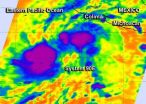(Press-News.org) There's a tropical low pressure area in the Eastern Pacific Ocean today, about 8 days before the official Eastern Pacific hurricane season begins. NOAA's National Hurricane Center is giving it a 50 percent chance of becoming a tropical depression in the next two days, and NASA's Aqua satellite passed overhead to gather infrared data on it.
NASA's Aqua satellite passed over developing tropical low pressure system 90E on May 8 at 08:41 UTC (4:41 a.m. EDT) and infrared data from the Atmospheric Infrared Sounder (AIRS) instrument aboard, showed that some of the thunderstorms had high, cold cloud top temperatures as cold as -63F/-52C, indicating there was some strong uplift in the system.
According to the National Hurricane Center (NHC), System 90E is a broad area of low pressure located about 400 miles south-southwest of Manzanillo, Mexico (south-southeast of Michoacán state coast). The low pressure area consists of a large area of cloudiness and thunderstorms. The system is still organizing and satellite data suggest that it still lacks a well-defined center.
NHC expects System 90E to move northeastward toward the southwestern coast of Mexico, so residents should pay attention to it. According to NOAA, conditions today, May 7 at 12:00 p.m. EDT at Colima, which is located on the southwestern Mexico coast, were mostly cloudy skies with calm winds and a temperature of 71F (22C).
Even if not a tropical depression, low pressure areas containing thunderstorms with cold cloud top temperatures as those seen in today's AIRS imagery, can still drop heavy rainfall. NHC noted that "Regardless of development...locally heavy rains will begin to affect portions of southwestern Mexico today."
NHC says that this systems as a medium chance (50 percent) of becoming a tropical cyclone during the next 2 day and 5 days.
INFORMATION:
Text credit: Rob Gutro
NASA's Goddard Space Flight Center
NASA watching year's first tropical low headed for southwestern Mexico
2014-05-07
ELSE PRESS RELEASES FROM THIS DATE:
Automated CT dose-tracking software effectively monitors dosage in a clinical setting
2014-05-07
Leesburg, VA, May 5, 2014—Dose-tracking software provides effective and easy monitoring of radiation dose exposure in a busy academic practice, according to research conducted at Massachusetts General Hospital.
For commonly ordered abdominal CT exams, iterative reconstruction techniques enabled approximately 50 percent radiation dose reduction compared to the national averages reported in the Dose Index Registry*.
"A busy practice with diverse CT technology and remote scanner locations encounters challenges in assessing institutional performance in lowering radiation ...
Breast tomosynthesis after screening mammography reduces need for ultrasound, biopsies
2014-05-07
Leesburg, VA, May 5, 2014—Breast tomosynthesis in the diagnostic workup for one- or two-view focal asymmetry detected at screening mammography resulted in less use of ultrasound, fewer biopsies, and higher positive predictive value for cancer than when diagnostic exams involved only 2D mammography, according to a study conducted at the University of Virginia.
"Tomosynthesis has been evaluated in screening populations and been shown to decrease recall rates," said researcher Brandi Nicholson, "but studies in the diagnostic setting are lacking."
Five hundred thirty ...
CT-guided irreversible electroporation safe in unresectable pancreatic carcinoma
2014-05-07
Leesburg, VA, May 6, 2014—A small group of patients with locally advanced unresectable pancreatic carcinoma suffered no major ill effects—pancreatitis or fistula formation—after undergoing percutaneous CT-guided irreversible electroporation (IRE)—a nonthermal ablation technology that is safe near vascular and ductal structures—as a therapy.
"Our findings exceeded our expectations," said Maria Paola Belfiore, a researcher at the Institute of Radiology, Second University of Naples. "In fact, three patients were downstaged, and so had a greater life expectancy. This is a ...
Rising CO2 poses significant threat to human nutrition
2014-05-07
Boston, MA — At the elevated levels of atmospheric CO2 anticipated by around 2050, crops that provide a large share of the global population with most of their dietary zinc and iron will have significantly reduced concentrations of those nutrients, according to a new study led by Harvard School of Public Health (HSPH). Given that an estimated two billion people suffer from zinc and iron deficiencies, resulting in a loss of 63 million life years annually from malnutrition, the reduction in these nutrients represents the most significant health threat ever shown to be associated ...
Study urges caution in stem cell clinical trials for heart attack patients
2014-05-07
CINCINNATI – A new study in Nature challenges research data that form the scientific basis of clinical trials in which heart attack patients are injected with stem cells to try and regenerate damaged heart tissue.
Researchers at Cincinnati Children's Hospital Medical Center and the Howard Hughes Medical Institute (HHMI), report May 7 that cardiac stem cells used in ongoing clinical trials – which express a protein marker called c-kit – do not regenerate contractile heart muscle cells at high enough rates to justify their use for treatment.
Including collaboration from ...
Greenland melting due equally to global warming, natural variations
2014-05-07
The rapid melting of Greenland glaciers is captured in the documentary "Chasing Ice." The retreat of the ice edge from one year to the next sends more water into the sea.
Now University of Washington atmospheric scientists have estimated that up to half of the recent warming in Greenland and surrounding areas may be due to climate variations that originate in the tropical Pacific and are not connected with the overall warming of the planet. Still, at least half the warming remains attributable to global warming caused by rising carbon dioxide emissions. The paper is ...
As CO2 levels rise, some crop nutrients will fall
2014-05-07
CHAMPAIGN, Ill. — Researchers have some bad news for future farmers and eaters: As carbon dioxide levels rise this century, some grains and legumes will become significantly less nutritious than they are today.
The new findings are reported in the journal Nature. Eight institutions, from Australia, Israel, Japan and the United States, contributed to the analysis.
The researchers looked at multiple varieties of wheat, rice, field peas, soybeans, maize and sorghum grown in fields with atmospheric carbon dioxide levels like those expected in the middle of this century. ...
Scientists create first living organism that transmits added letters in DNA 'alphabet'
2014-05-07
LA JOLLA, CA—May 7, 2014—Scientists at The Scripps Research Institute (TSRI) have engineered a bacterium whose genetic material includes an added pair of DNA "letters," or bases, not found in nature. The cells of this unique bacterium can replicate the unnatural DNA bases more or less normally, for as long as the molecular building blocks are supplied.
"Life on Earth in all its diversity is encoded by only two pairs of DNA bases, A-T and C-G, and what we've made is an organism that stably contains those two plus a third, unnatural pair of bases," said TSRI Associate Professor ...
Vascular simulation research reveals new mechanism that switches in disease
2014-05-07
BOSTON -- Blood vessel formation is critical to life and its manipulation is instrumental to a number of diseases. For more than 40 years, investigations into the structure and function of endothelial cells lining the blood vessels have revealed a complex tissue with complex functions, demonstrating that endothelial cells participate in all aspects of vascular homeostasis and pathological processes.
Today, important revelations regarding endothelial cell behavior are emerging from vascular simulation research, a blossoming interdisciplinary field that makes use of novel ...
Airborne measurements confirm leaks from oil and gas operations
2014-05-07
During two days of intensive airborne measurements, oil and gas operations in Colorado's Front Range leaked nearly three times as much methane, a greenhouse gas, as predicted based on inventory estimates, and seven times as much benzene, a regulated air toxic. Emissions of other chemicals that contribute to summertime ozone pollution were about twice as high as estimates, according to the new paper, accepted for publication in the American Geophysical Union's Journal of Geophysical Research: Atmospheres.
"These discrepancies are substantial," said lead author Gabrielle ...


